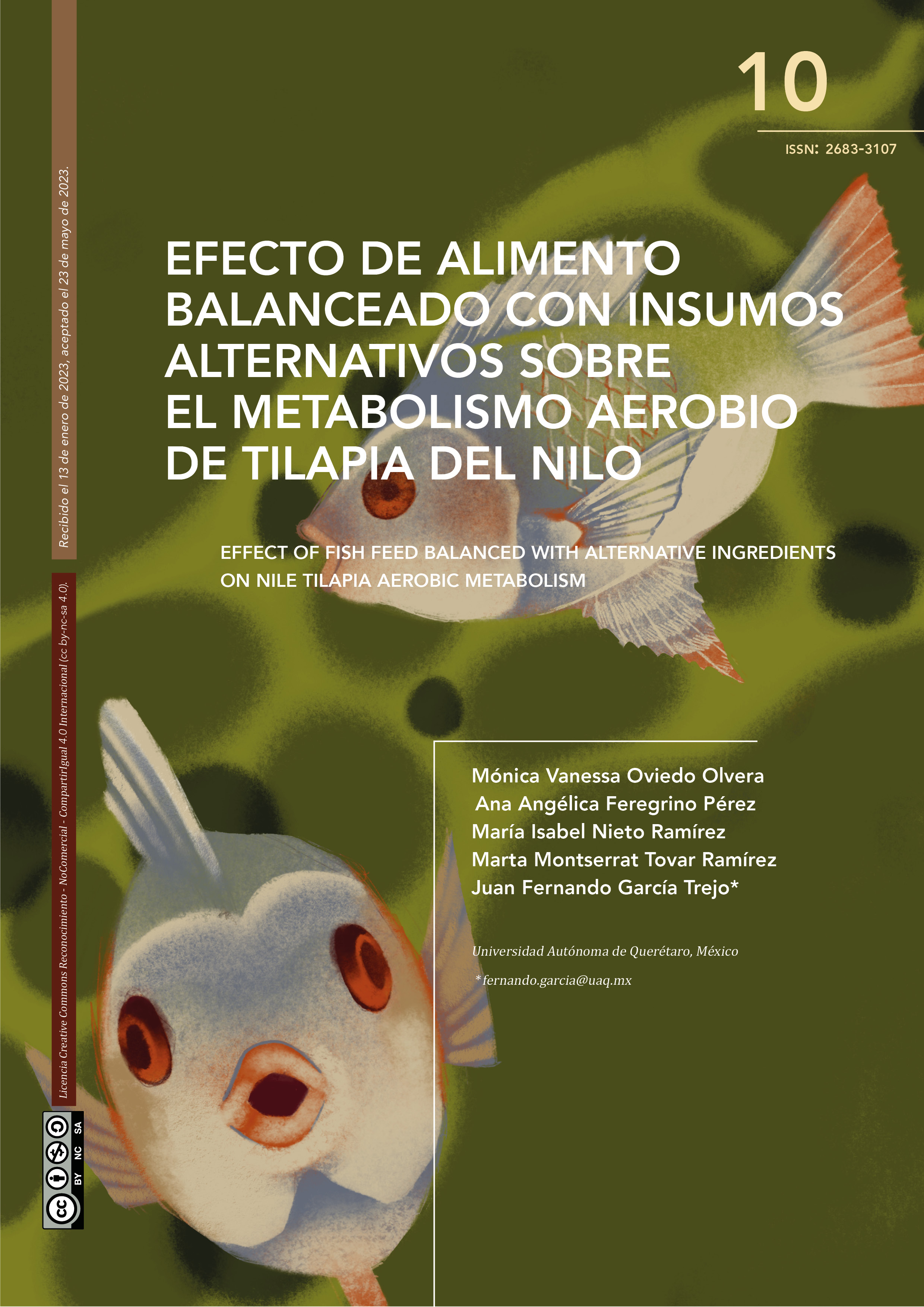Abstract
Aquaculture has opted for new feeds development balanced with alternative ingredients to fishmeal in order to maintain its rapid development and sustainability. Among most relevant inputs are microalgae and black soldier fly larvae due to their macro and micronutrient content. The objective of this work was to analyze the effect of a balanced feed with these inputs on the aerobic metabolism of Nile tilapia. Both alternative inputs inclusion decreased oxygen consumption in fish and lower ammonium excretion, which is related with a better utilization of protein by organism. Likewise, both parameters are involved in stress condition, so experimental diets also reduced stress due to change of feeding in tilapias. Microalgae and black soldier fly larvae turned out to be viable alternative ingredients for aquaculture feeds development without affecting fish growth performance and metabolism.
References
FAO, The State of World Fisheries and Aquaculture 2020. 2020.
K. Hua et al., “The Future of Aquatic Protein: Implications for Protein Sources in Aquaculture Diets,” One Earth, vol. 1, no. 3, pp. 316–329, 2019, doi: 10.1016/j.oneear.2019.10.018.
L. Gasco et al., Feeds for the Aquaculture Sector. Springer International Publishing, 2018.
R. Magalhães, A. Sánchez-López, R. S. Leal, S. Martínez-Llorens, A. Oliva-Teles, and H. Peres, “Black soldier fly (Hermetia illucens) pre-pupae meal as a fish meal replacement in diets for European seabass (Dicentrarchus labrax),” Aquaculture, vol. 476, pp. 79–85, 2017, doi: 10.1016/j.aquaculture.2017.04.021.
C. Nasopoulou and I. Zabetakis, “Benefits of fish oil replacement by plant originated oils in compounded fish feeds. A review,” LWT - Food Sci. Technol., vol. 47, no. 2, pp. 217–224, 2012, doi: 10.1016/j.lwt.2012.01.018.
R. Sathasivam, R. Radhakrishnan, A. Hashem, and E. F. Abd_Allah, “Microalgae metabolites: A rich source for food and medicine,” Saudi J. Biol. Sci., vol. 26, no. 4, pp. 709–722, 2019, doi: 10.1016/j.sjbs.2017.11.003.
M. R. Shah et al., “Microalgae in aquafeeds for a sustainable aquaculture industry,” J. Appl. Phycol., vol. 30, no. 1, pp. 197–213, 2018, doi: 10.1007/s10811-017-1234-z.
M. Henry, L. Gasco, G. Piccolo, and E. Fountoulaki, “Review on the use of insects in the diet of farmed fish: Past and future,” Anim. Feed Sci. Technol., vol. 203, no. 1, pp. 1–22, 2015, doi: 10.1016/j.anifeedsci.2015.03.001.
K. Hua, “A meta-analysis of the effects of replacing fish meals with insect meals on growth performance of fish,” Aquaculture, vol. 530, no. May 2020, p. 735732, 2021, doi: 10.1016/j.aquaculture.2020.735732.
P. Mayzaud and R. Conover, “O:N atomic ratio as a tool to describe zooplankton metabolism,” Mar. Ecol. Prog. Ser., vol. 45, pp. 289–302, 1988, doi: 10.3354/meps045289.
M. F. Abdelghany, H. B. El-Sawy, S. A. A. Abd El-hameed, M. K. Khames, H. M. R. Abdel-Latif, and M. A. E. Naiel, “Effects of dietary Nannochloropsis oculata on growth performance, serum biochemical parameters, immune responses, and resistance against Aeromonas veronii challenge in Nile tilapia (Oreochromis niloticus),” Fish Shellfish Immunol., vol. 107, pp. 277–288, 2020, doi: 10.1016/j.fsi.2020.10.015.
H. Muin, N. M. Taufek, M. S. Kamarudin, and S. A. Razak, “Growth performance, feed Utilization and body composition of nile tilapia, Oreochromis niloticus (Linnaeus, 1758) fed with different levels of black soldier fly, Hermetia illucens (Linnaeus, 1758) maggot meal diet,” Iran. J. Fish. Sci., vol. 16, no. 2, pp. 567–577, 2017.
K. Hua, “A meta-analysis od the effects of replacing fish meals with insect meals on growth performance of fish,” Aquaculture, vol. 530, no. 735732, 2021, doi: 10.1016/j.aquaculture.2020.735732
F. J. Fawole, A. A. Adeoye, L. O. Tiamiyu, K. I. Ajala, S. O. Obadara, and I. O. Ganiyu, “Substituting fishmeal with Hermetia illucens in the diets of African catfish (Clarias gariepinus): Effects on growth, nutrient utilization, haemato-physiological response, and oxidative stress biomarker,” Aquaculture, vol. 518, no. December 2019, p. 734849, 2020, doi: 10.1016/j.aquaculture.2019.734849.
S. López-Tejeida, J.F. García-Trejo, L. Félix-Cuencas, J.J. De León-Ramírez, M. Villegas-Villegas and L.B. Flores-Tejeida, “Nitrogen excretion and oxygen consumption on hyper intensive tilapia Oreochromis niloticus culture using three different commercial diets,” Lat. Ame. J. Aqua. Res., vol.48, no. 5, pp. 11, 2020, doi: 0.3856/vol48-issue5-fulltext-2539
Z. Zheng, C. Jin, M. Li, P. Bai, and S. Dong, “Effects of temperature and salinity on oxygen consumption and ammonia excretion of juvenile miiuy croaker, Miichthys miiuy (Basilewsky),” Aquac. Int., vol. 16, no. 6, pp. 581–589, 2008, doi: 10.1007/s10499-008-9169-7.
M. W. Feeley, D. D. Benetti, and J. S. Ault, “Elevated oxygen uptake and high rates of nitrogen excretion in early life stages of the cobia Rachycentron canadum (L.), a fast-growing subtropical fish,” doi: 10.1111/j.1095-8649.2007.01645.x.

This work is licensed under a Creative Commons Attribution-NonCommercial-ShareAlike 4.0 International License.
Copyright (c) 2024 Perspectivas de la Ciencia y la Tecnología

